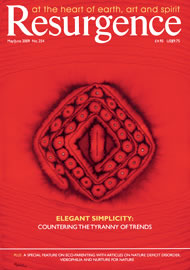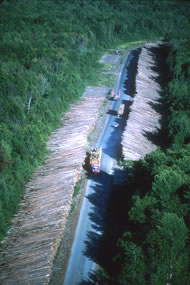THE IDEA OF following the trail of paper – from tree, through pulp to office – is a compelling one. In Paper Trails, Mandy Haggith aims to do just that, travelling to pristine forests, plantations, pulp mills and paper factories. Her investigations take her across the world from Canada to China, Indonesia to Russia.
She tells us that an average person in the UK uses over 200kg of paper a year; that world paper use is currently running at 335 million tonnes per year. I had some idea of the inequalities of the world’s paper use, and of the staggering quantities used by Europe and the US, but not that in Somalia the annual average use is merely four sheets of A4, whilst in Laos the average person uses less paper a year than someone in the UK gets through in a day. Unfortunately, reading through this first chapter felt like wading through an impenetrable forest of facts, like being lectured to by a passionate and single-minded campaigner but without any visual aids.
This is one of the main problems with this book. In isolation, these facts mean fairly little and are not in themselves enough to galvanise anyone into action; neither do they help to create a holistic understanding of the impact that paper consumption is having on the world. Facts are difficult to read and likely to turn many readers off. If this chapter were the only one to be written in this way it would be forgivable as it does give important background information; however, there are too many similarly tedious passages throughout the book, making my reading of it a stilted and reluctant process. Worse than this, on at least two occasions the author makes fundamental errors with some of her calculations.
Where the book does succeed is when she writes poetically about the journey itself: the trees, the forests, and the people living and working amongst them. She encounters people from a variety of backgrounds, including loggers, ex-loggers, farmers and campaigners. Her style in these parts of the book is beautiful, captivating and much more emotive. I found the chapter set in Indonesia particularly moving. As well as seeing illegal logging, she describes the plight of farmers whose crops are failing as a result of the environmental damage caused by nearby plantations. After the primary hardwood forest has been felled, multinational companies plant acacia trees, fast-growing aliens from Australia which suck the watercourse dry, leaving a decimated landscape. The plantations “destroy forests, eliminate biodiversity, dry up water courses, leave toxins in the soil and spread invasively,” summarises Haggith. She also broadens her environmental perspective, tackling the human rights issues of how companies are felling or planting on land belonging to indigenous people, and their use of intimidation and security forces.
These segments really do bring home the importance of saving our primary forests and the human impact of the paper trade. This type of writing personalises the issues, highlighting the senselessness of destroying ancient majestic trees for paper that is used once and then discarded. This aspect of the book puts the whole issue into context in a way that a bunch of facts and figures do not. The book would have had more impact if it were left as a travelogue with a twist. I particularly enjoyed the chapters on Canada and was moved almost to tears by the destruction of the old-growth forests there in our mission to consume.
It’s not all negative, however. The author emphasises the impact just one person can have on the policies of a company and how such actions can snowball, making a positive difference.
The final chapters of this book tackle the pulp and paper mills and the environmentally damaging processes that they use. Haggith ends on a positive note, encouraging readers to make a difference and cut down their own paper use. She concludes, “I am, ultimately, optimistic.” If, with all her travelling and knowledge, she’s optimistic, then hopefully I can be, too. •







